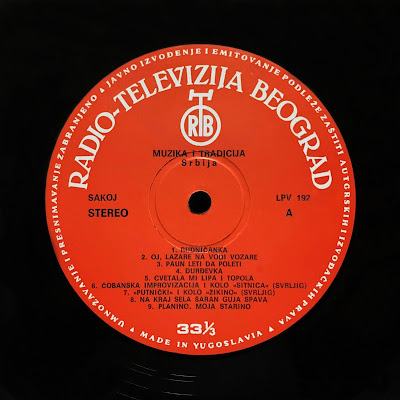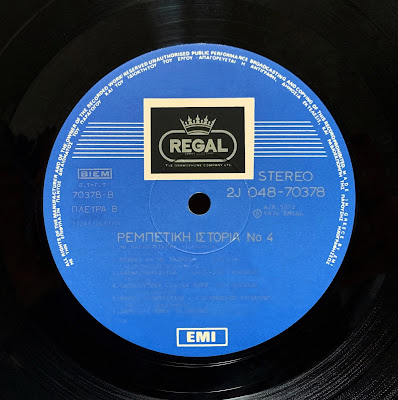INDIA – INDE
Lakshmi Shankar – Sings Khayal, Thumri & Bhajan – His Master's Voice – ECSD 2782, published in 1977 (LP)


Lakshmi Shankar (1926-2013) was born into a prominent South Indian Brahmin family in Madras (Chenai) and rose to become a preeminent Hindustani vocalist of the Patiala Gharana, who introduced Indian classical vocals to Western audiences along with Carnatic vocalist M.S. Subbulakshmi (1916-2004).
Shankar (née Sastri) was recognized as a gifted singer from childhood, but focused more on Bharatanatyam dance at the behest of her mother, for whom this time-honored traditional dance represented a cultural renaissance in India. After attending a performance of dancer and choreographer Uday Shankar’s (1900-1977) dance troupe in Chenai in 1939, she was inspired to enroll in his Almora Centre dance school and soon became a part of his troupe. In 1941, she married Shankar's brother Raju, becoming sister-in-law to Uday and their younger brother, sitar maestro Ravi Shankar (1920-2012). When brothers Raju and Ravi produced their ballet version of Jawaharlal Nehru’s Discovery of India in 1947, Lakshmi danced the lead before exhilarated audiences. But shortly after, she fell severely ill with pleurisy and was forced to give up her promising dancing career at the age of 20.
After a hiatus of several years, the trailblazing Shankar continued to push back against gender and geographical boundaries by embracing Hindustani singing under the tutelage of Abdul Rehman Khan, of the Patiala Gharana style, beginning in 1954. Thanks to her prodigious musical gifts, as well as her significant knowledge of the Carnatic tradition, in just three years Shankar gave her first recital (in Kolkata in 1957), which marked the beginning of a brilliant classical singing career in India and abroad.
This rare album is one of Shankar’s finest. Released in 1977, it features the virtuoso Carnatic violin player Dr. L. Subramaniam (b. 1947) on violin, Prabhakar Pednekar on harmonium, and Zakir Hussain (b. 1951) on tabla. Shankar’s clear, lyrical, and gracefully melodious flights and her utterly luminous interactions with Subramaniam’s vocal-like violin are suffused with serene intensity.
Lakshmi Shankar (1926-2013), née dans une famille brahmane de l'Inde du sud à Madras (Chenai), devint une chanteuse Hindustani majeure du Patiala Gharana et fut l'une des premières artistes à présenter du chant classique indien auprès d'un public occidental avec la chanteuse Carnatic M.S. Subbulakshmi (1916-2004).
Après avoir développé un don pour le chant dès son plus jeune âge, Lakshmi Shankar (née Satri) se focalisa sur la danse Bharatanatyam suite aux encouragements de sa mère qui considérait que l'apprentissage de cette art traditionnel participait à la renaissance culturelle de l'Inde. Après avoir assisté à une représentation de la troupe de danse d'Uday Shankar (1900-1977) à Chenai en 1939, elle s'inscrit au centre de danse Almora d'Uday Shankar et rejoindra sa troupe peu après. En 1941, elle épousa Raju Shankar et devint ainsi la belle-sœur d'Uday et de leur jeune frère, le maître du sitar Ravi Shankar (1920-2012). Lorsque Raju et Ravi produisent le ballet de Discovery of India de Jawaharlal Nehru en 1947, Lakshmi danse le rôle principal devant un public enthousiaste. Peu de temps après, elle tomba gravement malade en raison d'une pleurésie qui la contraint subitement d’abandonner sa prometteuse carrière de danseuse à l'âge de 20 ans.
Après une pause de plusieurs années, cette pionnière continua de faire reculer les frontières géographiques et les limitations sociales imposées aux femmes en se donnant corps et âme au chant Hindustani sous la tutelle d'Abdul Rehman Khan du Patiala Gharana à partir de 1954. Grâce à ses prodigieux dons musicaux et sa connaissance de la tradition Carnatic, Shankar donne son premier récital dès 1957 à Calcutta qui marquera le début d'une brillante carrière de chanteuse classique en Inde et à l'étranger.
Cet album rare de Lakshmi Shankar publié en 1977 est l'un de ses tout meilleurs. Elle est accompagné ici du virtuose Dr. L. Subramaniam (né en 1947) au violon, de Prabhakar Pednekar à l'harmonium et de Zakir Hussain (né en 1951) aux tablas. Ses envolées mélodieuses précises, lyriques et gracieuses, ainsi que ses interactions lumineuses avec le violon très vocal de Subramaniam, sont imprégnées d'une intensité sereine.
“My first performance outside India was in 1962. I came with Uday Shankar as his music director and he made me sing a separate bhajan solo for seven minutes. In 1968 I came with Ravi ji [Ravi Shankar] for the festival of India. We toured coast to coast for a lot of concerts and at that time the audience had just started getting hooked on [Indian] instrumental music. They had not heard much vocal music. So Ravi ji told me to sing short pieces and initially I’d shorten a khayal rendition to a mere 20 minutes. That was all people could take at the time. Now after 30 years I see a change and that people can hear a long rendition of over an hour and still enjoy it. They were mainly Westerners and there were not many Indians living here at that time.”
“Even in India a few years back there was a big void in the audience because the younger generation was not interested in listening. (…) In the old days, we started at 9 p.m. and sang till 3.30 a.m. Now no one has the stamina for that. We had two nine-hour concerts in France though and people sat through them. Here I really enjoy performing in San Francisco maybe because of Ali Akbar Khan’s music school, the audience is very well versed in the classical music of India and ready to listen.”
















